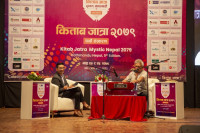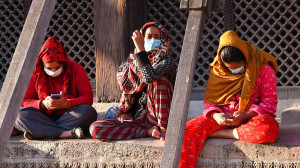Culture & Lifestyle
Art as dialogue and activism
Manish Lal Shrestha, founder of Gallery Mcube, reflects on how rituals, temple rhythms, and communal practices inspire his contemporary art.
Reeva Khanal
Manish Lal Shrestha is a multidimensional visual artist and curator based in Kathmandu. A graduate of Sir JJ School of Fine Art, Mumbai (2001), Shrestha merges contemporary motifs with Nepal’s evolving artistic identity. He is also the founder of Gallery Mcube, an independent art space that supports contemporary practices through residencies, exhibitions, and cross-cultural collaborations.
In this conversation with the Post’s Reeva Khanal, Shrestha reflects on the intersections of ritual, sound, and performance in his practice, and how tradition and modernity continue to shape his creative journey.
Your work focuses on ritual and sound—how did you first discover these themes, and how do they continue to drive your practice?
Growing up in the cultural heart of Patan Durbar Square, I was influenced by the rhythms of daily rituals, the resonance of sound, and the performative nature of tradition. The chants, temple bells, and communal gatherings were more than just traditions; they were living performances that shaped my understanding of space, rhythm, and connection.
Over time, I began to explore these influences through my art, seeking to bridge the spiritual and the contemporary while evoking presence, memory, and transformation. These ritualistic practices, omnipresent in my surroundings, continue to shape my perception of life and resonate throughout my artistic journey. For me, art—like ritual—is an act of renewal and a shared experience.
How has your exposure to diverse art environments influenced the way you integrate traditional elements with modern perspectives?
I developed a sensitivity to the spiritual, ritualistic, and communal aspects of art at a very early age. Later, my engagement with contemporary art movements and global creative dialogues broadened that understanding, allowing me to view tradition not as nostalgic but as a dynamic source of inspiration and reinterpretation.
I strive to translate social realities into visual and sensory experiences, using sound as a medium to evoke awareness and reflection. Over time, my practice has expanded to include performance, installation, public, and community art—enabling me to engage with people and spaces beyond the confines of a gallery.
As the founder of Gallery Mcube, what do you believe is the role of galleries and institutions in nurturing art in Nepal?
With the establishment of Gallery Mcube, I’ve come to see galleries as more than just exhibition spaces—they are platforms for dialogue, experimentation, and community building. In Nepal’s evolving art landscape, where tradition and contemporary practice coexist, such spaces play a vital role in bridging local and global perspectives.
At Gallery Mcube, our focus is on nurturing and sustaining the creative process through exhibitions, workshops, international residencies, collaborations, and artistic exchange. We aim to support both emerging and established voices while bringing art closer to the community. I believe galleries today must act as cultural catalysts—engaging with social and environmental issues.
In recent years, we’ve witnessed protests and social movements in which art, meme culture, and street installations have played a significant role in expressing dissent. What role do you see art and artists playing in social activism in Nepal?
This country has seen a powerful movement led by the younger generation, with art emerging as one of the most vital voices of collective consciousness. From protest banners and murals to digital memes and street performances, art has become a compelling medium of resistance.
I believe the artist’s role in such movements goes beyond documenting or reflecting the moment—it is to provoke dialogue, challenge complacency, and envision new possibilities. Art provides a space for honesty and expression, transforming frustration into creativity and solidarity.
Through their sensitivity and imagination, artists give voice to the unheard, turning struggles into shared stories of resistance and hope. In this way, art serves both as a mirror and a catalyst—revealing the realities of our time while inspiring the courage to transform them. Artists, ultimately, are the protectors of freedom of speech.
Looking back on your journey as an artist, curator, and institution-builder, what project taught you the most?
One of the most defining moments in my journey was the establishment of Gallery Mcube. It was more than just opening a space—it was about creating a platform where artists could experiment freely, collaborate across disciplines, and connect with audiences beyond conventional gallery systems.
Before that, my practice was mostly individual and introspective. However, building an institution required me to shift from thinking solely as an artist to thinking like a facilitator and community builder. I began to understand the broader ecology of art—how space, dialogue, and exchange can nurture artistic growth.
Through curating exhibitions and residencies, I learned that every artist brings a new world of ideas and energy, and nurturing those conversations can be as transformative as creating art itself. This realisation changed my approach entirely; I now see art as a shared process that connects creators, viewers, and contexts in meaningful ways.
Through community projects such as the ‘Get Well Soon Project’ and ‘Project 1336’, I’ve gathered experiences that have shaped my personal and artistic growth.
Manish Lal Shrestha’s five book recommendations
Francis Bacon: Revelations
Author: Mark Stevens and Annalyn Swan
Publisher: Knopf
Year: 2021
This book reveals the emotional intensity behind one of the 20th century’s most provocative painters.
Frida: A Biography of Frida Kahlo
Author: Hayden Herrera
Publisher: Harper Perennial
Year: 1983
Herrera traces the extraordinary life of Frida Kahlo, exploring her art, struggles, and cultural impact.
Art and Politics Now
Author: Anthony Downey
Publisher: Thames & Hudson
Year: 2014
This currently relevant book by Downey engages with politics, activism, and the way artists respond to global events.
Sāṅkhya Kārikā
Author: Īśvarakṛṣṇa
Publisher: Motilal Banarsidass
Year: 1882 (Originally published)
A foundational text of Indian philosophy that explores the principles of Sāṅkhya and the nature of reality and liberation.
The World Is Flat
Author: Thomas L Friedman
Publisher: Farrar, Straus and Giroux
Year: 2005
A global perspective on the interconnected modern world, analysing technological advances and economic shifts.




 14.12°C Kathmandu
14.12°C Kathmandu













%20(1).jpg&w=300&height=200)

